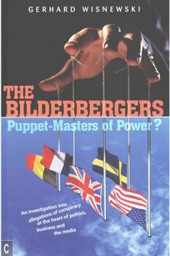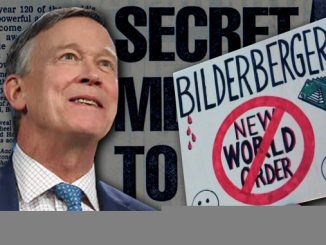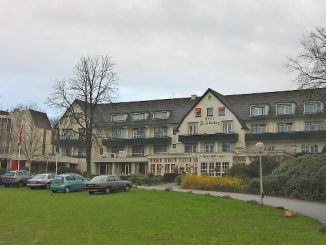
Surprisingly, this year’s Bilderberg conference was covered by The New York Times and The Washington Post, likely because of the attendance of Jared Kushner, Mike Pompeo, and Stacey Adams. Globalists want Silicon Valley’s help on censorship, election fixing, and new war technology.
By Mark Anderson
Several ironies and surprises surround the 2019 Bilderberg conference that ran May 30-June 2 in Montreux, Switzerland, not the least of which were reasonably substantial reports in two of America’s leading members of the mass media cartel—The New York Times and The Washington Post.
Why all the fuss from media giants that usually downplay or ignore Bilderberg? Well, the big media’s favorite target, President Donald Trump, sent his chief adviser and son-in-law Jared Kushner and Secretary of State Mike Pompeo to Bilderberg, along with several National Security Council and Office of the Secretary of Defense personnel—not to mention the attendance of possible Democratic presidential candidate Stacey Abrams, the radical black leftist attorney who lost her bid for Georgia’s governorship.
The Times noted in a May 31 piece:
Secretary of State Mike Pompeo is on a weeklong trip to Europe where he is raising sensitive issues with national leaders—from Iranian missiles to Chinese technology to the economic collapse of Venezuela—but the most colorful conversations could take place this weekend out of public earshot in a secretive conclave at a Swiss lakeside resort.
It didn’t seem to occur to the Times that perhaps such sensitive matters shouldn’t even be discussed at Bilderberg, whose participants, representing a broad spectrum of government and corporate power, could have unknown personal connections and may leak sensitive information about U.S. national security—a key problem with Bilderberg to begin with. At any rate, the Times called Bilderberg’s 67th meeting in 65 years “an annual forum in which participants agree not to reveal exactly what was said or who said it. It is a shadow version of Davos, the elite annual winter conference in the Swiss Alps that President Trump has attended once but has also criticized.”
While that last passage could almost be mistaken for the late AFP Bilderberg hound Jim Tucker’s writings, what the Times didn’t disclose is that another Times reporter—renowned national security writer David E. Sanger—was already inside Bilderberg as a listed participant.
The Times’s duplicity was matched by the Post. While Post writer Adam Taylor scribbled a screed that combined poking fun at Bilderberg’s critics with tidbits of real reporting, he pled ignorance about what Bilderberg might ultimately be discussing, to wit:
The involvement of key Trump administration members may spark criticism from those who view the meetings as nefarious gatherings of the global elite. Conspiracy theorists, including a number who have publicly supported Trump, have picketed the event in recent years . . . . The meeting’s website lists topics for discussion this year, including “China,” “Russia,” “Brexit” and “Climate Change and Sustainability.” One thing not listed, however, is the topic that is apparently driving Pompeo’s visit to Europe: Iran, which the Trump administration claims poses a growing threat . . . . Could the world’s power brokers end up discussing Iran anyway? Perhaps. But it’s unlikely that we’ll ever know.
Really? Taylor could simply huddle with fellow Post writer Megan McArdle, who joined Sanger inside Bilderberg. And the Bilderbergers’s famed Chatham House Rule needn’t be an obstacle; the Post’s intrepid reporters certainly could pump Megan for information and dodge the rule.

Meanwhile, the alternative press on the ground endured very trying circumstances. Dan Dicks of Press for Truth, Luke Rudkowski of We Are Change, and Glen Bolton of the Conspiracy Cabbie were detained at the Geneva airport while photographing and questioning stone-cold silent invitees to the Bilderberg meeting.
They did spot former Google CEO Eric Schmidt as he strolled outside the Bilderberg meeting to ask him whether Bilderberg has had anything to do with de-platforming online conservative-constitutional commentators, with nerdy Schmidt brusquely brushing off the questions. Yet these hard-working reporters were the ones being questioned by police who politely searched them several times. Dicks remarked that freedom of the press seems to nosedive whenever Bilderberg is in town.
Guardian reporter Charlie Skelton, whose annual writings on Bilderberg extended to Newsweek online this year, walks the fine line between mainstream and alternative reporting on Bilderberg. In a witty and in many ways insightful Newsweek piece he noted:
As the war machine gets smarter, and every last bit of weaponry becomes AI-enhanced, the lines between Silicon Valley and the Pentagon start to [blur]. Sniff this year’s Bilderberg and you can smell this new kind of war: “cyber threats” and “the weaponization of social media” are on the agenda … . This blurring of tech and war takes physical form in some of the participants at Bilderberg. Longtime conference insider and former Google CEO Eric Schmidt chairs the Pentagon’s Defense Innovation Board and also heads up the new National Security Commission on Artificial Intelligence.
Two other members of the Defense Innovation Board are here in Montreux: Reid Hoffman [of LinkedIn] and psychologist Adam M. Grant. Alongside Schmidt on the Bilderberg Steering Committee are [two more] tech billionaires, Alex Karp and Peter Thiel. Karp is the CEO of Palantir, a shady data-analytics company which has just won a massive $800 million Pentagon battlefield intelligence contract. Palantir was set up in 2004 by Peter Thiel with backing from the CIA.
Those are some interesting observations, but consider some highlights of the greater Bilderberg network that often are overlooked by both mainstream and alternative media:
2019 Bilderberg attendee Fernando Medina, the mayor of Lisbon, flew immediately from Switzerland to attend the Pritzker Forum on Global Cities in Chicago June 5-7, where the elevation of municipal power to the global level to sidestep the nation-state was the central theme. That forum, which sees the global cities movement as a means of countering the populist uprising that Bilderberg fears, included a presentation on “Resilient Cities,” a Rockefeller Foundation-backed project that involves technological input from Karp’s Palantir firm.

The Trilateral Commission, the younger and somewhat more open Bilderberg sibling which in many ways makes Bilderberg’s dealings more visible, for the first time ever held its annual North American Regional Meeting in Silicon Valley, Calif., Nov. 16-17, 2018. Interestingly, the Trilaterals’ European Regional meeting held the same month included Canadian “anti-PC” psychology professor Jordan Peterson as one of its speakers, addressing “A Provocation: Will Liberal Democracy Survive?” That meeting also included 2019 Bilderberg participant José Manuel Barroso, former European Commission president.
And 2019 Bilderberg attendee Microsoft CEO Satya Nadella is partnering with two highly suspect companies, NewsGuard and ElectionGuard, to police cyberspace for “fake news” and re-tool our election machinery to make elections more “accountable,” even while NewsGuard, which involves using real editors instead of computer algorithms to weed out suspected “disinformation,” has advisory board members and investors tied to Bilderberg, the CIA, CNN, and the global cities movement.
The reality is that today’s Bilderberg is just one of several groupings within a network that constitutes a powerful private tier of government. And the network’s architects are pressing onward, despite being at an apparent crossroads: The Trilateral Commission’s 2019 plenary meeting took place June 14-16 in Paris and the commission’s next European meeting will be Nov. 22-24 in Stockholm, Sweden.
Mark Anderson is AFP’s roving editor. Email him at [email protected].




